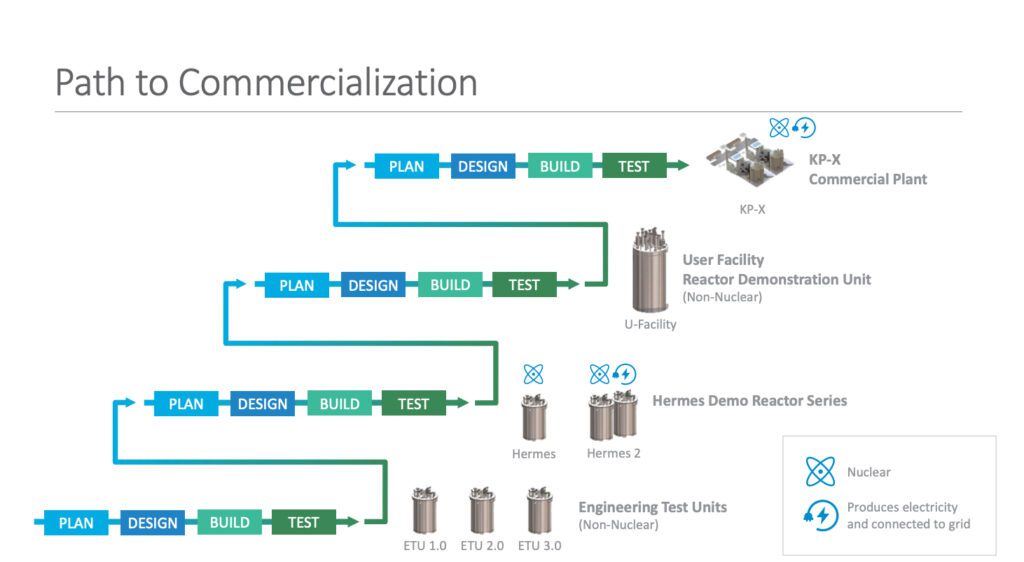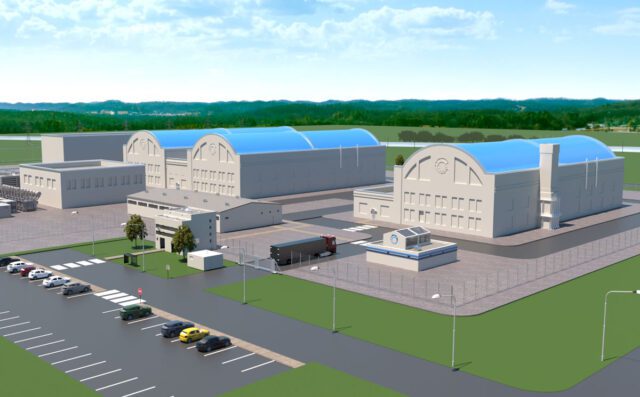Kairos Power Gets NRC Green Light for Second Molten Salt Nuclear Facility
The Nuclear Regulatory Commission (NRC) has wrapped up its final safety evaluation for Kairos Power’s Hermes 2 “low power” advanced test facility, comprising two 35-MWth test molten salt reactors—similar to the Hermes 1 “non-power” demonstration reactor for which the regulatory body issued a construction permit in December 2023.
The NRC’s action, announced on July 22, concluded no safety aspects preclude issuing a construction permit for the facility. Kairos has proposed to build Hermes 2 at the East Tennessee Technology Park Heritage Center (ETTP) site in Oak Ridge, Tennessee, alongside the proposed single 35-MWth Hermes 1 test reactor, a non-nuclear engineering test unit, and potential future Kairos Power fuel fabrication facility. It plans to begin operating Hermes 2’s two units—a combined electrical output of 20 MWe—by December 2027, anticipating they would have a licensed lifetime of 11 years.
The action marks another milestone for the Alameda, California–headquartered engineering company that is developing and marketing nuclear power plant designs based on its fluoride salt-cooled, high-temperature reactor (KP-FHR) technology. The company is pursuing a notable “rapid iterative development approach,” which involves using iterative hardware demonstrations and in-house manufacturing “to achieve disruptive cost reduction and provide true cost certainty for commercialization.”

A Risk-Averse Rapid Iterative Approach
For now, Kairo anticipates a KP-FHR commercial reactor could be operational in the early 2030s. As POWER has reported, Kairos’s KP-FHR comprises a graphite-moderated, “randomly packed” pebble‐bed reactor with molten fluoride salt coolant (a chemically stable molten fluoride salt mixture of 2LiF:BeF2 [Flibe] enriched in Li‐7), operating at high temperature and near‐atmospheric pressure. The fuel in the KP-FHR is based on tri-structural ISOtropic (TRISO) particle fuel in pebble form with a carbonaceous‐matrix coated particle design.
Kairos kicked off the iterative process with substantial development of the Engineering Test Unit (ETU), a non-nuclear, unenriched Flibe-wetted and isothermal integrated test at the company’s KP-Southwest research and development facility in Albuquerque, New Mexico. Kairos is also already producing Flibe for the ETU program at its June 2022–commissioned Molten Salt Purification Plant (MSPP) at specialty materials company Materion’s campus in Elmore, Ohio.
On July 1, ETU 1.0 began decommissioning after six months—more than 2,000 hours—of pumped salt operations. The unit used 12 metric tons of Flibe, reaching 675C at peak with a salt flow rate of 3,000 gallons per minute. The company has also made progress to kick off ETU 2.0 in Albuquerque, and ETU 3.0, which will be built in Oak Ridge, next to the Hermes 1 and 2. ETU 2.0 and 3.0 are slated to demonstrate modular construction and accelerate the company’s civil construction experience.
UP-AND-RUNNING: @KairosPower completed 1,000 operating hours on the largest FLiBE molten salt system ever built.
It will be used to inform the design, construction, and operation of its Hermes reactor.
Learn more: https://t.co/mbUWXEEaxF pic.twitter.com/6FlgSQaamk
— Office of Nuclear Energy (@GovNuclear) January 11, 2024
In December 2023, the NRC granted Kairos a construction permit for its 35-MWth Hermes molten salt “non-power” demonstration reactor. The NRC’s approval for Hermes 1, notably, marked its first green light for the construction of a non-water-cooled reactor in more than 50 years. The NRC accepted Kairos’ construction permit application for Hermes 1 in November 2021. The company is now awaiting a separate approval for an NRC operating license before it can begin operating the Hermes demonstration to comply with the two-step 10 CFR Part 50 licensing process. Kairos has told POWER it is targeting mid-2026 as an initial commissioning date for Hermes 1.
In June 2023, meanwhile, the NRC formally accepted for review a construction permit application (CPA) for the next iteration, Hermes 2, a two-unit demonstration that would produce “low-power” electricity. Hermes 2 is set to be deployed in Oak Ridge on the same site as the first Hermes demonstration “to further de-risk technology, construction, supply chain, and licensing for a multi-reactor plant,” Kairos has said.
Hermes 2 will comprise two 35-MWth test reactors that share a steam-powered (Rankine Cycle) conversion system. “The design builds upon the Hermes 1 test reactor design and contains the following three major design changes: (1) each test reactor has an intermediate salt loop to transfer heat from the reactor, (2) each intermediate salt loop has a steam superheater that feeds a common turbine in the shared power conversion system, and (3) the lifetime of the facility is 11 years instead of the four year lifetime of Hermes 1,” Kairos says in its NRC filings. The facility will be licensed under 10 CFR Part 50.21 (a class of licenses for medical therapy and research and development facilities).
“Hermes 2 shares many of the same safety characteristics of Hermes 1,” Kairos added. “They both use TRISO-fueled pebbles in Flibe, resulting in a high-temperature low-pressure system with the following robust inherent or passive safety characteristics: functional containment provided by TRISO fuel and Flibe; primary heat transport system that operates near atmospheric pressure; negative reactivity coefficients (fuel, moderator, and coolant temperature); and reactor vessel and other safety-related components located within a seismically-isolated structure.”

Hermes 2 Anticipated to Begin Operation in 2027
For now, Kairos has urged the NRC to review and approve the Hermes 2 CPA by April 2025 to support the construction of safety-related structures, systems, and components. “The earliest start date for construction is expected to be July 2025; the earliest projected date for completion of construction for the first unit is July 2027, and the latest projected date for completion of the first unit is December 2027. The completion of construction for the second unit is expected to be one year after the first unit,” the company notes.
The NRC on Monday said its Final Safety Evaluation Report (FSER) for Hermes 2 aligned with findings from the independent Advisory Committee on Reactor Safeguards. The NRC is now expected to complete Hermes 2’s final environmental assessment later this summer as the final phase of the licensing process. “The Commission will determine whether the staff’s review supports the findings necessary to issue the [construction] permit. Following its deliberations, the Commission will vote on whether to authorize the staff to issue the permit,” it said.
The NRC’s review of the reactor has been notably efficient. Andrea Veil, director of the NRC’s Office of Nuclear Reactor Regulation, said on Monday that the FSER for Hermes 2 was completed “nearly four months ahead of schedule, and using about 60% fewer resources than expected, using insights from our previous Kairos review.”
As POWER reported last year, the NRC also completed its FSER for Hermes 1 in 18 months, “well ahead of schedule.” Veil on Monday said the regulatory body remains “committed to applying these sorts of lessons learned to maintain safety while promptly and efficiently processing applications.”
Kairos on Monday suggested the NRC’s efficiency was in large part due to the company’s foresight. “We are proud to have partnered with the NRC on an effective and efficient review and are delighted with the staff’s completion nearly four months ahead of schedule,” said Peter Hastings, Kairos Power vice president of Regulatory Affairs and Quality. “We have expended a tremendous effort to provide all the necessary information to support the staff’s findings while identifying opportunities to streamline review processes and demonstrating definitively that advanced reactors can be licensed under the existing regulatory framework.”
Darrell Gardner, senior director of Licensing at Kairos, meanwhile, noted that the company’s efforts are well aligned with the NRC’s newly updated process for streamlining the mandatory hearing. “We look forward to continuing to discern possibilities for additional efficiencies. Demonstrating regulatory successes is not only essential to advancing Kairos Power’s mission to enable the clean energy transition; it is also important to reinforce the nation’s nuclear energy leadership goals,” he said.
—Sonal Patel is a POWER senior editor (@sonalcpatel, @POWERmagazine).